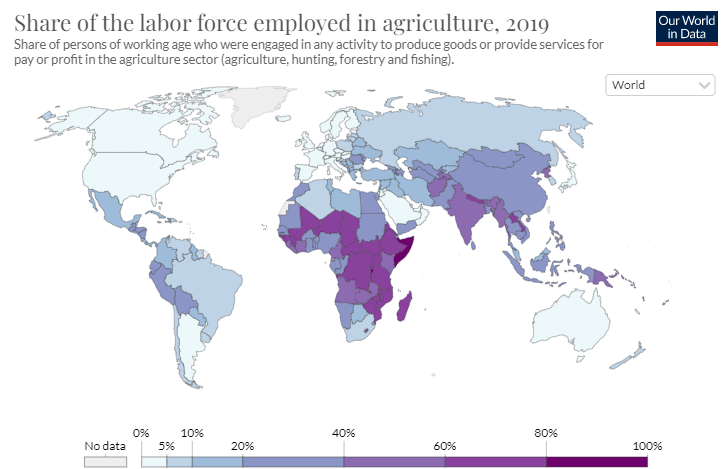LINKS WE LIKE #33
"Agriculture is civilization”- E. Emmons
In our modern world, the quote above may seem simplistic, but perhaps it is still true. The root of human civilization (and survival) lies in our ability to produce food. The “civilizing” effect of agriculture is an established historical fact. The area known as the Fertile Crescent is where irrigation and agriculture began around 12,000 years ago. The resulting influx of travellers led to an exchange of ideas (writing, mathematics, religion), and other hallmarks of modern civilization; including densely-populated cities, centralized governments, and specialized occupations. Unfortunately, these advancements were also accompanied by social stratification, with hierarchies developing alongside private wealth accumulation. We now find ourselves on the verge of the next “agricultural revolution”, with Artificial Intelligence (AI) and agriculture coming together. In this edition of Links We Like, we explore the effects that this linkage will create.
A History of Innovation
Due to the outsize impacts of agriculture, each major “shift” has been accompanied by rippling effects on individuals and societies. Following the aforementioned “First Agricultural Revolution” (Fertile Crescent) and the rise of civilization, the Second Agricultural Revolution occurred in Great Britain in the 18th century. With the increase in productivity (due mostly to new machinery and crop rotation), food supplies also increased, allowing for the formation of more densely populated cities and demand for consumer goods that would contribute to the Industrial Revolution. The third “Green Revolution” of the 1960s, driven mainly by new chemicals, pesticides, and seed varieties, resulted in massive gains in productivity and production. In turn, the world witnessed steep declines in food insecurity (and the sharp increase of the human population we have witnessed since that time.)
The Fourth Agricultural Revolution
We now stand on the precipice of what many refer to as the Fourth Agricultural Revolution, resulting from the use of AI (and related technologies.) Many exciting new possibilities seem to exist, including autonomous robots that can undertake the growing and picking of crops, as well as the care of livestock. These technologies have potential to help meet serious challenges related to food security and environmental degradation caused by current agricultural practices, including reducing CO2 emissions. They could also free workers from the types of manual labor currently associated with agriculture and help to attract a new generation of farmers. Thus far, much of the political conversation around this “revolution” has been optimistic and AI agribusiness has attracted major funding. So, what could possibly go wrong on the inevitable march towards this bright, technologically-enhanced future?
Shared Success?
The story of agriculture, like so many others in the modern world, is one of two “worlds”, rich and poor. In developed economies, the percentage of people working in agriculture is around 1 in 100. Those rates rise to over 70% in many developing economies. Additionally, those in the Global South are much more likely to suffer from food insecurity and are more vulnerable to commodity price shocks. These factors combine to make technological improvements into a highly pertinent issue in the developing world, and concerns regarding equitable access to new technologies, such as AI, have already arisen. As this revolution continues, inclusion of countries and populations with limited access to infrastructure, capital, and capacity to implement AI systems will only grow in importance, to ensure that no one is “left behind”.
Signs of Hope
Fortunately, initiatives are already underway to bring these new innovations to smallholder farmers in many countries. One example is SunCulture, which is already improving crop yields and annual income for Kenyan farmers, as well as reducing manual labor hours. By utilizing TV white spaces (TVWS) to expand high-speed internet access, they are also helping to make precision farming possible in underserved areas. Additionally, the AGRA alliance is working together with farmers, local governments, development agencies, and businesses to bring locally appropriate technologies to farmers across the African continent. These are just a few examples of many diverse groups and stakeholders already working to ensure that the benefits of new technologies are equally shared.
Join us examining other ways in which AI is already impacting agriculture, and what we might expect in the future. Resources are available in English, Spanish and Arabic.
In 38 minutes, this podcast outlines the promising impacts that advanced technologies can have on agriculture. Interviewee David Davies, founder and CEO of AgUnity, discusses the mobile app he developed to help farmers in developing countries: AgriLedger. This app serves farmers by doing exactly what blockchain was designed to do: create a permanent, tamper-proof ledger to build trust between different actors in the production chain. The app allows farmers to conduct a variety of transactions (e.g. hiring custom seeders and harvesters, cooperate and negotiate with other farmers, get their crop to market and track them throughout the production process, etc.). By strengthening collaboration and creating more value at the farm level, AgriLedger has been able to triple farm income in the two completed pilot projects; in Kenya for wheat farmers, and in New Guinea for cocoa bean growers. In addition, AgriLedger automates record keeping and reduces waste, making this a sustainable agriculture project.
Con el fin de garantizar la subsistencia de millones de personas, es fundamental potenciar la seguridad alimentaria y la calidad agrícola. Uno de los productos más consumidos en América Latina es la yuca, cuyo cultivo se extiende en diferentes países de la región y del mundo, y garantiza la subsistencia de más de 800 millones de personas. Data la importancia de garantizar que estos cultivos no padezcan de plagas, enfermedades u otros problemas que puedan dañar la yuca, científicos del Centro Internacional de Agricultura Tropical (CIAT) de Cali, Colombia, han desarrollado un modelo de aprendizaje automático para estudiar las raíces de los cultivos. Los científicos utilizan drones, aprendizaje computarizado y sensores de penetración para estudiar el desarrollo del suelo de los cultivos de yuca, y cómo estas condiciones influyen en el crecimiento de las plantas.

Los científicos han logrado fusionar datos de las imágenes captadas por los drones, analizarlas con el software de aprendizaje automático y entender cómo estos tubérculos responden a los estímulos en el campo en tiempo real. Según Diego Sánchez, investigador del grupo Agroclimatología y Ecofisiología de Cultivos Tropicales de Agrosavia, Colombia, “el método y la plataforma presentada por los investigadores puede ayudar y facilitar el trabajo de los cultivadores de yuca en el mundo”.
Kathleen Walch deeply explores the benefits of AI implementation in the agricultural sector. First, the author examines how, by utilizing Big Data analysis, farmers can evaluate weather conditions, temperature, and water usage to make more appropriate business decisions. In addition, this data analysis also contributes information on soil, light, food and water requirements, and facilitates the reduction of greenhouse gas emissions. Moreover, AI systems are used to detect plagues and pests in plants, to create probability models to predict seasonal forecasting and, consequently, to reduce the risk of crop failure. Similarly, algorithms serve as tools to calculate economic trends, prices, and supply management.
During last year’s online event “AI, Food for All”, FAO, IBM and Microsoft, discussed concrete ways through which AI can contribute to food security, while safeguarding natural resources and addressing challenges such as climate change and the impacts of shocks, including the COVID-19 pandemic. So far, AI in farming is emerging in three major areas: agricultural robotics, soil and crop monitoring, and predictive analytics. Two best practices models were presented: FAO’s WaPOR portal, which monitors and reports on agriculture water productivity throughout Africa and the Near East, and The Agricultural Stress Index System (ASIS), a quick-look indicator developed by FAO for the early monitoring of agricultural areas with a high likelihood of water stress/drought at global, regional and country levels, using satellite technology.
في هذه المقالة، يتناول الكاتب علي قاسم أهمية الثورة الزراعية التي من خلالها أتاحت التكنولوجيا فرصاً جديدة للمزارعين والفلاحين، و السؤال الأهم الذي يطرح نفسه هو عن استعداد الدول العربية للاستفادة من هذه الثورة دون الانجرار إلى التحديات والتغيّرات التي قد تحمل آثاراً وعوائق اقتصادية واجتماعية وسياسية جذرية وعميقة،. وبالتفصيل، يتناول الكاتب تكنولوجيا الذكاء الاصطناعي التي بات يستخدم فيها المزارعون طائرات دون طيار وجرارات وآلات حصاد وقطف ثمار مبرمجة للعمل وحدها، من البذار إلى مراقبة المحاصيل ووصولا إلى جنيها، ذلك عبر استخدام نظام ال جي. بي.أس. والهاتف الذكي أو شاشة الكمبيوتر. وينتقل من أسرار الروبوتات إلى الحلول الفعالة والطرق المسدودة في هذا المجال، والمعوقات الثلاث الأساسية: نقص المياه، تقلّص الأراضي الصالحة للزراعة، و الهجرة من الريف نحو المدينة. قد تكون الدول العربية من أكبر المستفيدين من التكنولوجيا الحديثة، رغم أنه من الممكن التغلب على التحديات والعوائق، إلّا أن هذا الأمر يعود إلى إمكانية توظيف التكنولوجيا الحديثة عبر خلق الحكومات الدعم اللازم والمناسب لإستخدامها.
Further Afield
Upcoming Events:
- December 7: Data Collection and Artificial Intelligence: The Best Technologies for the Benefit of the Farmer. Event covering the development of agricultural robotics and autonomous systems.
AI, Food Security and Food Waste:
- How AI Can Unlock a $127B Opportunity by Reducing Food Waste
- Artificial Intelligence Could Stop Millions from Going Hungry by 2030
- How AI-Driven Technology Is Increasing Food Security, And Improving The Lives Of Farmers Worldwide
- How Technology can Help Avert Food Waste
- Can the Wi-Fi chip in Your Phone Help Feed the World?
- Nosh Uses AI to Help People and Businesses Cut Down on Their Food Waste
- AI for Agriculture and Global Food Security with Nemo Semret [Podcast]
Future of Farming:
- The Future of Farming: Artificial Intelligence and Agriculture
- Pushing the Bounds of Future Farming
- AI Helps Design the Perfect Chickpea
- Will Artificial Intelligence Solve Some of the Pressing Issues in Namibian Agriculture
- Using Artificial Intelligence, Agricultural Robots are on the Rise
- Being a Farmer in the Age of Robotics and AI [Ted Talk]
- COP26 Spotlight: Eagle Genomics and New Frontier of Microbiome Data
Benefits and Innovations:
- Artificial Intelligence for Agriculture Innovation
- How Artificial Intelligence is Improving Agriculture [Podcast]
Digitalization:
- Digitalization and AI in European Agriculture: A Strategy for Achieving Climate and Biodiversity Targets?
- Data-as-a-Tool to Empower Smallholder Farmers
Machine Learning:
Gender:
- Supporting Women Farmers in the Age of Climate Change: Why It’s Time To Look at Agriculture Solutions Through Both a Gender and Climate Lens
- This Woman Entrepreneur’s Start-up has Developed an AI-based Crop Protection Drone for Climate-smart Agriculture
Links in Spanish:
- La inteligencia artificial al servicio de la agricultura
- Innovaciones de la inteligencia artificial en la agricultura de precisión
- John Deere y la Inteligencia Artificial en la agricultura
- La aplicación de las mejores prácticas de la inteligencia artificial en el contexto de la agricultura puede ayudar a superar la brecha digital y, al mismo tiempo, hacer frente a la inseguridad alimentaria
- Inteligencia artificial en la agricultura, llave de la productividad
- Estudio del uso de técnicas de inteligencia artificial aplicadas para análisis de suelos para el sector agrícola
- El Internet de las cosas y la inteligencia artificial, al servicio de una agricultura de alta precisión
- Robótica e inteligencia artificial para salir del hambre
- Agricultura con inteligencia artificial en zonas rurales




![M002 - Feature Blog Post [WEB]](https://datapopalliance.org/wp-content/uploads/2025/10/M002-Feature-Blog-Post-WEB.png)





